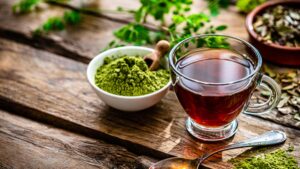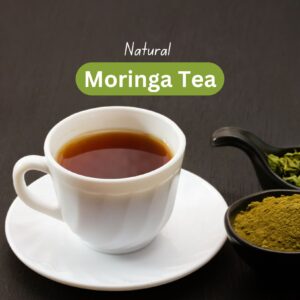If you’re looking to learn about Moringa, your search ends here.
1. Introduction
Moringa, also known as “The Miracle Tree,” is a fast-growing, drought-resistant tree native to parts of South Asia and Africa. Its nickname stems from its remarkable ability to offer a wide array of benefits for health, nutrition, and even the environment. Unlike many plants, almost every part of the Moringa tree—leaves, pods, seeds, flowers, and roots—can be used for food, medicine, or other practical applications.
Popularity of Moringa
In recent years, Moringa has seen a surge in popularity across the globe, earning recognition as a superfood. This rise is largely due to its dense nutritional profile, which includes high levels of vitamins A, C, and E, calcium, potassium, and protein. The tree is also packed with antioxidants and anti-inflammatory compounds, making it a natural choice for health enthusiasts and those seeking holistic remedies.

Its popularity is not just confined to health food stores; Moringa is now a key ingredient in dietary supplements, energy drinks, skincare products, and functional foods. Beyond its health benefits, Moringa is celebrated for its role in combating malnutrition in developing countries and its potential to support sustainable farming practices.For more queries read me.
In this blog, we’ll dive deeper into what makes Moringa such an extraordinary plant, exploring its origins, nutritional value, health benefits, and diverse applications, as well as why it’s being hailed as a solution to some of the world’s biggest challenges.
2. Origins and History
Native Regions
Moringa is believed to have originated in the foothills of the Himalayas in northwestern India. Over time, it spread to tropical and subtropical regions across Africa, Southeast Asia, and Latin America. The tree thrives in arid climates and poor soil conditions, making it an ideal crop for areas with limited agricultural resources. Today, Moringa is cultivated globally, particularly in countries like India, the Philippines, Kenya, and Senegal.If you want to known about Magic spoon cereal click me.
Historical Uses in Traditional Medicine and Cuisine
For centuries, Moringa has been valued in traditional medicine systems like Ayurveda and Unani. In Ayurveda, it is said that Moringa can prevent or cure nearly 300 diseases. Its leaves, seeds, bark, and roots have been used to treat a wide range of ailments, including digestive issues, skin problems, and inflammation.

In African and Asian cuisines, Moringa pods (often called drumsticks) and leaves are commonly used in soups, stews, and curries. The fresh leaves are also eaten as a vegetable, while dried leaves are turned into powder for tea or seasoning. Its seeds have been used for oil extraction and even water purification.
Cultural Significance Across the World
Moringa holds deep cultural and practical significance in many parts of the world:
India: Known as “Shigru” in Sanskrit and commonly used in Indian households, Moringa is a staple ingredient in dishes like sambar and murungai poriyal. It also features prominently in traditional remedies.
Africa: Moringa is often called the “Tree of Life” for its ability to fight malnutrition in backward regions. It’s a key part of many rural diets and is promoted by humanitarian organizations as a sustainable food source.
The Philippines: Known as “Malunggay”, Moringa is used in traditional dishes like tinola (a chicken soup) and valued for its health-boosting properties.
Haiti: Moringa is referred to as “Benzolive” and is widely used in reforestation programs due to its ability to thrive in harsh environments.

The historical and cultural significance of Moringa goes beyond its nutritional and medicinal properties. It has also been regarded as a symbol of life and resilience in regions where resources are scarce. From ancient traditions to modern health trends, Moringa continues to play a vital role in the lives of people around the world.
3. Nutritional Benefits
Overview of Vitamins, Minerals, and Antioxidants

Moringa is often described as a nutrient powerhouse because it contains a wide array of essential vitamins, minerals, and bioactive compounds:
Vitamins: High levels of vitamins A, C, and E support vision, skin health, and immune function.
Minerals: Rich in calcium, potassium, magnesium, and iron, which are essential for bone health, muscle function, and oxygen transport.
Protein: Moringa leaves contain all nine essential amino acids, making it a rare plant-based complete protein.
Antioxidants: Compounds like quercetin, chlorogenic acid, and beta-carotene combat free radicals and reduce oxidative stress.
Comparison to Other Superfoods
When compared to well-known superfoods, Moringa often surpasses them in nutrient density:
It has 7 times more vitamin C than oranges and 4 times more calcium than milk.
Its iron content is higher than that of spinach, making it an excellent option for anemia.
For complete video tutorial click me.
Moringa leaves contain more protein than kale and are particularly beneficial for vegans and vegetarians.
This impressive nutrient profile makes Moringa a valuable dietary addition, particularly for people in nutrient-deficient regions and those seeking natural health boosters.
—
4. Health Benefits
Immune System Support
Moringa is packed with immune-boosting nutrients like vitamin C, vitamin A, and zinc, which help the body fight off infections. Its antioxidants, such as quercetin and polyphenols, reduce inflammation and strengthen the body’s defense system. Consuming Moringa regularly can enhance the production of white blood cells, improving the body’s ability to ward off pathogens.
Anti-inflammatory and Antioxidant Properties

Moringa contains powerful anti-inflammatory compounds, such as isothiocyanates and flavonoids, which help reduce inflammation in the body. Chronic inflammation is linked to conditions like arthritis, asthma, and cardiovascular disease, and Moringa’s properties can help mitigate these risks.
The antioxidants in Moringa, including chlorogenic acid and vitamin E, neutralize free radicals, which cause cellular damage and aging. This makes Moringa beneficial for overall health and longevity.
Role in Managing Diabetes, Heart Health, and More
Diabetes Management: Studies show that Moringa helps regulate blood sugar levels by enhancing insulin sensitivity and slowing down the absorption of glucose. Chlorogenic acid, found in Moringa, is particularly effective in managing blood sugar spikes.

Heart Health: Moringa reduces bad cholesterol (LDL) and improves good cholesterol (HDL), lowering the risk of cardiovascular diseases. Its potassium content also helps regulate blood pressure.
Digestive Health: The fiber in Moringa aids digestion and prevents constipation, while its antibacterial properties protect against harmful gut bacteria.
Brain Health: Moringa’s antioxidants and neuroprotective compounds, such as vitamins E and C, may help reduce the risk of neurodegenerative diseases like Alzheimer’s.
Skin and Hair Health: With its high content of antioxidants and essential nutrients, Moringa promotes healthy skin by fighting oxidative stress and helps maintain strong, shiny hair.
Moringa’s versatility in addressing a wide range of health concerns highlights why it is regarded as a “miracle” tree in traditional medicine and modern wellness practices.
5. Culinary Uses
Common Ways to Incorporate Moringa into Diets
Moringa is a versatile ingredient that can be easily added to various meals and beverages:
Powder:
Dried Moringa leaves are ground into a fine powder, which can be mixed into smoothies, soups, or baked goods. The powder retains most of the nutrients and has a mild, earthy flavor.
Tea:
Moringa leaves can be brewed into tea, offering a refreshing drink packed with antioxidants.

Fresh Leaves:
Fresh Moringa leaves are often used as a vegetable in curries, soups, or stir-fries. They add a slightly bitter taste and a nutritional boost.
Pods:
Known as “drumsticks,” Moringa pods are commonly cooked in stews or curries, especially in Indian cuisine.
Recipe Ideas
Moringa Smoothie:
Blend Moringa powder with banana, spinach, almond milk, and a sweetener of choice for a nutrient-packed drink.
Moringa Soup:
Add fresh or powdered Moringa leaves to vegetable soup for added flavor and health benefits.
Moringa Omelet:
Mix chopped Moringa leaves into your egg batter for a nutritious twist on a classic breakfast.
Moringa Tea:
Steep dried Moringa leaves in hot water for 5–7 minutes and sweeten with honey.
—
6. Cultivation and Sustainability
How Moringa is Grown

Moringa is a hardy, fast-growing tree that thrives in tropical and subtropical climates. It requires minimal water and can grow in poor soil, making it ideal for arid and semi-arid regions. The tree can be grown from seeds or cuttings, and it begins to produce leaves within weeks of planting.
Farmers appreciate Moringa for its low maintenance and high yield. Additionally, it grows year-round, providing a constant source of food and income.
Environmental Benefits
Carbon Sequestration: Moringa trees absorb carbon dioxide, helping mitigate climate change.
Soil Fertility: The tree’s deep roots prevent soil erosion and improve water retention. Its leaves can also be used as organic fertilizer.
Water Purification: Moringa seeds have properties that can purify water, making it drinkable in areas with limited clean water access.
Role in Combating Malnutrition
Moringa plays a crucial role in addressing malnutrition in developing countries. Its leaves are rich in essential nutrients, making it an affordable and accessible source of vitamins, protein, and minerals. Humanitarian organizations often promote Moringa cultivation in impoverished areas to provide food security and fight nutrient deficiencies, particularly in children and pregnant women.
—
7. Conclusion
Moringa truly lives up to its title as “The Miracle Tree.” Its versatility, from its use in traditional medicine to modern dietary trends, makes it a valuable resource for people worldwide. As a nutrient-dense food, it supports health and wellness. Its sustainability benefits the environment, while its role in combating malnutrition highlights its global importance.

Incorporating Moringa into daily life—whether as a tea, in meals, or through supplements—can improve personal health while supporting a more sustainable future. As we continue to explore the many uses of Moringa, it becomes clear why this tree is revered as a symbol of life, resilience, and hope for a healthier world.


4 thoughts on “Moringa -The Miracle Tree”